Mi SciELO
Servicios Personalizados
Revista
Articulo
Indicadores
-
 Citado por SciELO
Citado por SciELO -
 Accesos
Accesos
Links relacionados
-
 Citado por Google
Citado por Google -
 Similares en
SciELO
Similares en
SciELO -
 Similares en Google
Similares en Google
Compartir
Enfermería Global
versión On-line ISSN 1695-6141
Enferm. glob. vol.20 no.61 Murcia ene. 2021 Epub 01-Feb-2021
https://dx.doi.org/10.6018/eglobal.417451
Originals
Therapeutic communication of the nurse, from the vision of the hospitalized in the General hospital Jaén, Peru
1Bachelor of Science in Nursing, Professor of Nursing. Toribio Rodriguez de Mendoza National University of the Amazon. Chachapoyas – Amazon, Perú.
2PhD in Public Health, Bachelor of Science in Nursing. Research Professor Toribio Rodriguez de Mendoza National University of the Amazon. Chachapoyas – Amazon, Perú.
3Professor Toribio Rodriguez de Mendoza National University of the Amazon. Chachapoyas – Amazon, Perú.
Objective:
Determine the level of therapeutic communication professional nursing from the perspective of people hospitalized in the Internal Medicine Service of the General Hospital Jaén, Peru.
Material and method:
Research quantitative, descriptive level; an observational, prospective and cross-sectional study, univariate statistical analysis. The sample was composed of 122 people hospitalized, It was used as an instrument of the "therapeutic communication Questionnaire" developed by Lourdes Guevara Chuquillanqui, which was validated by expert judgement as VC = 2.2 > VT = 1.6449 and a reliability of 0.92.
Results:
100% (122) of persons hospitalized; 71.3% (87) perceived a therapeutic communication of low level and the 28.7% (35) medium level. According to the dimensions: In empathy 86 (70.5%) perceived a therapeutic communication of low level, the 27% (33) Medium level and 2.5% (3) high level, in the respect dimension 67 (54.9%) perceived a therapeutic communication a low level, the 42.6% (52) a medium level and 2.5% (3) high level, in the dimension receptive listening 67 (54.9%) perceived a therapeutic communication of low level and the 45.1% (55) medium level, in the emotions of the patient 70 (57.4%) perceived a therapeutic communication of low level, the 34.4% (42) Medium level and 8.2% (10) high level, in the dimension accompanying upon their reflection the 68%
(83) earned a therapeutic communication of low level, the 68% (83) low level, 25.4% (31) Medium level and 6.6% (8) high level.
Conclusions:
In conclusion the perception of therapeutic communication of persons hospitalized was of low to medium level.
Keywords: Therapeutic communication; professional nursing; perspective; person hospitalized
INTRODUCTION
In the field of health care provision, many problems begin when communication is poor and notorious. One of them is inadequate communication with health professionals, which is the main cause of dissatisfaction among hospitalized people. Studies show that between 30 and 50% of hospitalized people do not adhere to treatment as a result of poor communication with staff (1.
Although communication is already recognized as essential, recent studies indicate that the interpersonal relations between hospitalized persons, nursing professionals and other health professionals is still not a priority in practice. Communication difficulties are observed between professionals and hospitalized persons, which can have a strong influence on satisfaction, adherence to treatment and consequently, on health outcomes, suggesting the need for a theoretical-practical and humanized change in health professionals (2,3.
According to studies carried out in Chile, hospitalized people make their perception of poor quality of care expressed as "lack of attention" or "cold treatment", refer that it is constant in patients hospitalized in the surgery service (42.3%) than in medicine (37.5%) 4
The humanized care of the nursing professional has a close relationship with therapeutic communication, which should be an important quality of the professional because it helps the patient to recover and adapt, so that the message transmitted to the patient is correctly understood. A supportive relationship must be established for the message to be fully understood 5) . Currently, many of the nursing professionals have become routine, focusing only on the administration of medications, filling out medical records, forgetting to provide effective therapeutic communication, leaving aside their own and the patient's well-being.
This work aims to raise awareness among nursing professionals in order to generate changes in the future by intervening positively in the professional relationship between nurses and hospitalized persons, which is therapeutic communication in nursing work. Given these arguments, the following question was asked in order to carry out this research:
How is the therapeutic communication of the nursing professional, from the perspective of the people hospitalized in the medical service of the General Hospital Jaén, Peru, considering that the opinion and experience of the hospitalized people is an important indicator of the therapeutic communication.
MATERIAL AND METHODS
Research type and design
Quantitative research; descriptive; of type: observational, prospective, cross-sectional, according to the number of variables of interest and univariate statistical analysis 6.
The research design was descriptive (6, which diagram was:
M: People hospitalized in the medical service.
O: Nurse's Perspective on Therapeutic Communication.
Population and sample
Universe / Population: 177 people hospitalized in the medical service of the General Hospital Jaén in April, during the years 2013 - 2016.
(Source: Filter of statistical data in Excel of income and expenses of the HGJ).
Sample: 122 hospitalized people applying formula for sample selection.
Sampling: convenience sampling, using the inclusion and exclusion criteria.
In the inclusion criteria
People hospitalized in the medical service who want to participate in filling out the questionnaire.
Minimum four days of hospitalization.
Age between 18 and 59 years old.
In the exclusion criterio
People who cannot write or read.
Those who are not able to respond (people in a coma, stroke, in a terminal state, among others).
Data collection instrument
Instrument made up of 25 items composed of five dimensions of therapeutic communication between nurses and hospitalized persons. An ordinal scale was used, with scores for each item of:
Never 1
Sometimes: 2
Always 3
The actual range of the instrument was:
- Maximum score: 75 points
- Minimum score: 25 points
Validity and reliability of the instrument
The survey validated by Bachelor Lourdes Guevara Chuquillanqui modified Likert scale type was used (8, which consists of a presentation, instructions, general data and content with 25 items and 3 alternative answers: always, sometimes, never; which was subjected to content and construct validity through the judgment of eight professional experts in the area, processed in the concordance table and the binomial test, validated with a score of 2.2. Subsequently, the pilot test was carried out in order to determine the statistical reliability by applying the Cronbach's alpha coefficient, obtaining an overall reliability of 0.92.
Data analysis
For the data analysis, descriptive frequency statistics were used applying central tendency tests such as the mean, mode and median. For the processing of the data obtained, it was statistically analyzed with the help of SPSS and the Excel 2016 spreadsheet (9.
RESULTS
In Table 1 and Figure 1, regarding the percentage of therapeutic communication, it can be observed that out of 100% (122) of the persons hospitalized, 71.3% (87) perceived a low level of therapeutic communication, which means that the nurse shows little interest, acceptance, understanding, provides poor treatment, lack of company and time, while 28.7% (35) presented a medium level.
Table 1. Percentage of nurse's therapeutic communication, from the perspective of those hospitalized in the General Hospital Jaén, Peru
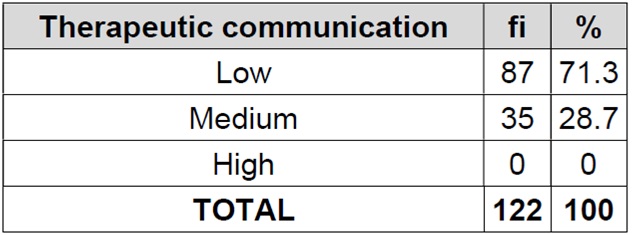
Source: Therapeutic communication assessment instrument.
Mode = 1, Median = 1, Mean = 1,3

Source: Own elaboration
Figure 1. Percentage of therapeutic communication by nurses, from the perspective of the Hospitalized in the General Hospital Jaén, Peru. The mastered level
Regarding the dimensions of therapeutic communication, in Table 2 and Figure 2 it can be seen that 100% (122) of hospitalized people; the dominant values they perceived was a low-level therapeutic communication for the empathy, respect, listening and receptive emotion dimensions of the patient and accompanying upon their reflection and, secondly, the medium level for all dimensions.
Table 2. Dimensions of the nurse's therapeutic communication from the perspective of those hospitalized in the General Hospital Jaén, Peru.
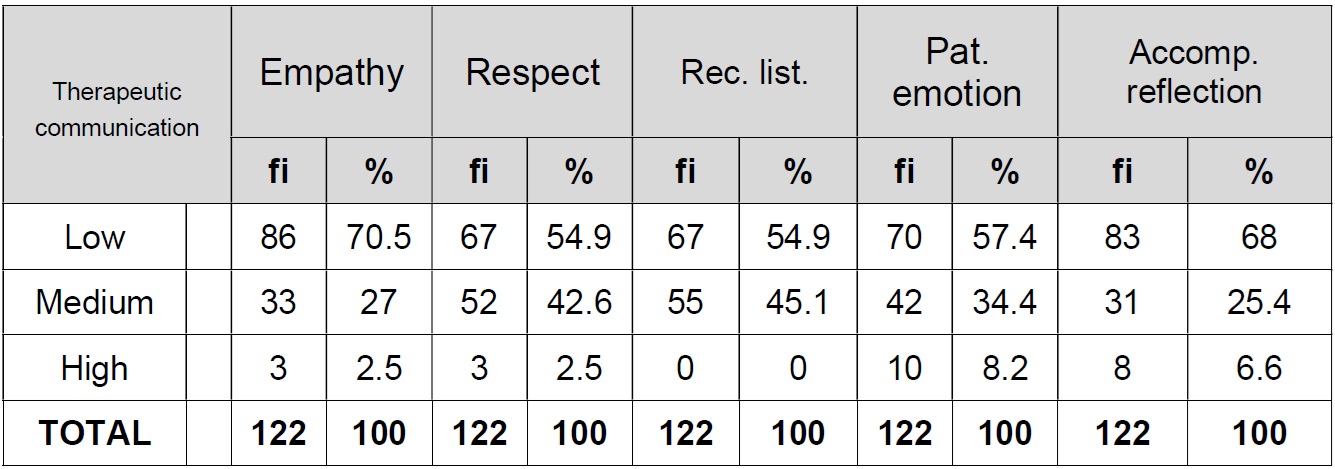
Resp. list.: Receptive listening, Pat. Emotion: Patient's emotion, Accomp. reflection.: Accompanying their reflection.

Source: Own elaboration
Figure 2. Dimensions of the nurse's therapeutic communication from the perspective of those hospitalized in the General Hospital Jaén, Peru
Hospitalized patients between 36 and 55 years of age considered a low level of communication, with only 13.4% in medium level, as reflected in Table 03.
Table 3. Relation between the age of the hospitalized persons and their perception of the nurse's therapeutic communication, in the General Hospital Jaén, Peru

Source: Instrument applied x2=6,987a
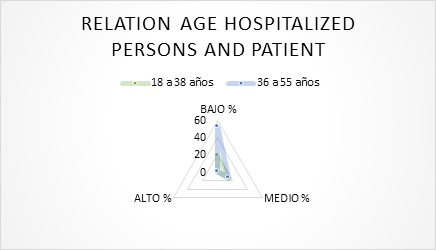
Source: Own elaboration
Figure 3. Relation between the age of hospitalized people and their perception of the nurse's therapeutic communication in the General Hospital Jaén, Peru
Regarding the origin, the hospitalized people of Jaén and Bellavista mostly considered a low level, but San Felipe and San José del Alto considered a medium level according to Table 4.
Table 4. Relation between the origin of the hospitalized persons and their perception of the therapeutic communication of the nurse in the General Hospital Jaén, Peru.
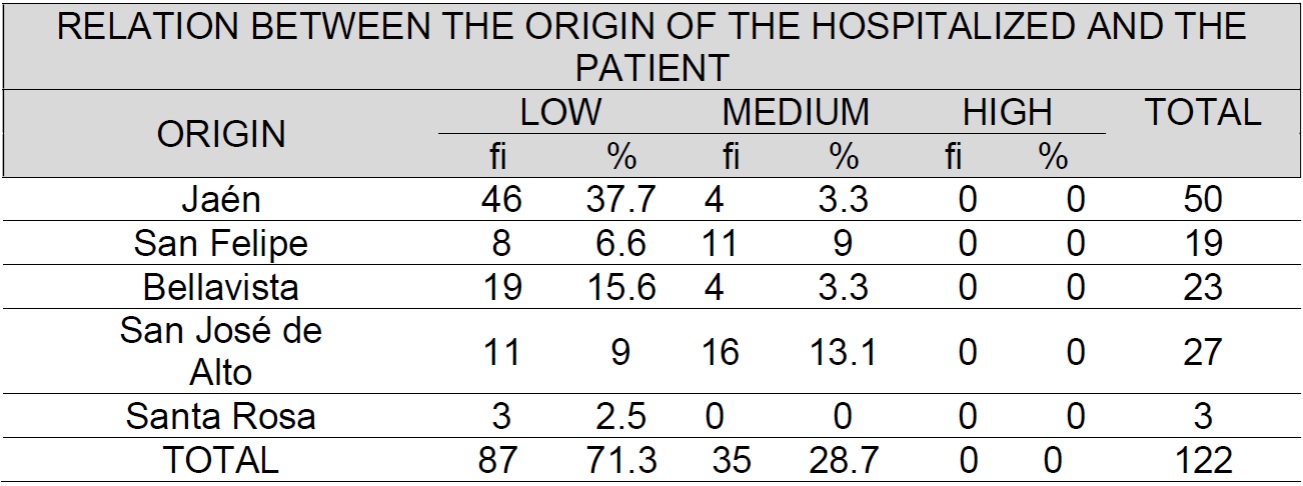
Source: instrument applied x2 = 33,359
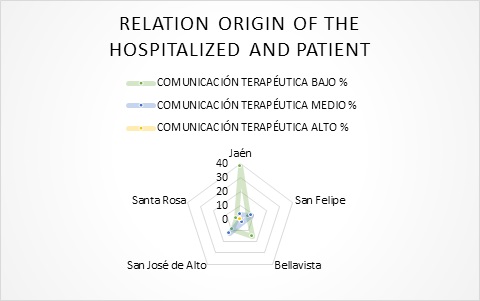
Source: Own elaboration
Figure 4. Relation between the origin of the hospitalized persons and their perception of the nurse's therapeutic communication in the General Hospital Jaén, Peru.
Regarding the employment situation, people who work dominate considering the existence of a low level of communication, with a 16.4% of the medium level, as shown in table 5.
Table 5. Relation between the employment situation of hospitalized persons and their perception of the therapeutic communication of the nurse, Hospital General Jaén, Peru

Source: Instrument applied x2 = 13,586ª

Source: Own elaboration
Figure 5. Relation between the work situation of hospitalized patients and their perception of the nurse's therapeutic communication in the General Hospital Jaén, Peru
All single people consider a medium level of therapeutic communication by the nurse, but they represent a minimal amount compared to married people, who consider communication at a low level, according to Table 6.
Table 6. Relation between the marital status of hospitalized persons and their perception of the nurse's therapeutic communication in the General Hospital Jaén, Peru.

Source: Instrument applied x2 = 12,960a

Source: Own elaboration
Figure 6. Relation between the marital status of hospitalized patients and their perception of the nurse's therapeutic communication in the General Hospital Jaén, Peru
Table 7. Relation between days of hospitalization of hospitalized persons and their perception of the therapeutic communication of the nurse in the General Hospital Jaén, Peru.

Source: Instrument applied x2 = 18,471ª
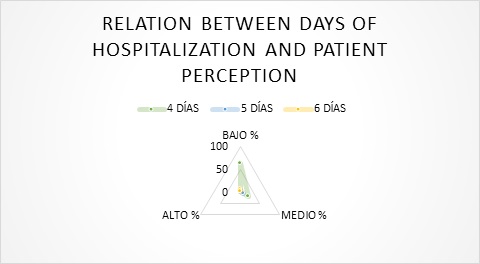
Source: Own elaboration
Figure 7. Relation between patient hospitalization days and perception of the nurse's therapeutic communication in the General Hospital Jaén, Peru.
The relation between the days of hospitalization of the patients and the perception of the therapeutic communication of the nurse was, for the most part, distributed over the four days of hospitalization, being catalogued as low, which reflects the little empathy of the nurses during the first days.
DISCUSSION
When contrasting with other research such as the one by Vargas10) in his study Perception and satisfaction about the treatment received from the nurse to people cared for in the Hospital María Auxiliadora-Rodríguez de Mendoza (Amazon), it is observed that of 100% of the hospitalized people (65), 50.8% (33) had a regular perception of the treatment received by the nurse; 49.2% (32), had a positive perception without any negative evidence, which shows that the nurse was dedicated to the patient. In the study by Huamán (11, entitled Perception of the hospitalized person about humanized nursing care in the general surgery service. Virgin of Fátima Regional Hospital, Chachapoyas, out of 100% (90) of the people hospitalized, 74.4% (67) perceived humanized care, followed by 15.6% (14) who rated it as excellent and 10% (9) as regular. It should be noted that, unlike the General Hospital in Jaén (Peru), these hospitals - the Amazon and Chachapoyas ones - have a large number of nurses whose main task is to care for the hospitalized people, ready to meet their needs as expressed by each of them. However, the demand of patients, the work routine and the reduced time for each shift is a limitation for the nurse to carry out their duties properly. In the area of surgery, this variable is more advanced in its deterioration, according to studies carried out in Chile (12.
On the other hand, Ynga 13 in his study Perception of the hospitalized person about their interrelation with the nursing professional. Virgin of Fátima Regional Hospital (Chachapoyas) found that out of 100% (111) of people, 55% (61) established an unfavorable patient-nurse relationship, 45% (50) showed a favorable perception of this interrelationship; this demonstrates that, among more people surveyed, the results are similar to those of this research. The results vary according to the days of hospitalization and the quantity and quality of professionals who take care of people and the service they are in.
Grados14 found that 100% (45) of patients rated over 60% of the nurse's verbal communication as inadequate. In the non-verbal dimension, more than 68% of patients rated the nurse's communication as "inexpressive", "withdrawn posture", "elusive" and "inattentive”. According to this study, nurses show a weakness in their therapeutic communication, and in view of Hildegard E. Peplau's theory of interpersonal relationships, the same conclusion is reached because they do not exercise effective therapeutic communication with hospitalized persons, as they fail to recognize their difficulties and needs, show little interest in the situation of the hospitalised person and do not use the services 100%. Lastly, the hospitalised person assumes their independence on a regular basis, according to the results of Guevara8. Regarding the quality of the nurse-patient relationship, an average of 60 % (12) established a medium quality of relationship; an average of 30 % (6) established a poor quality of relationship and 10 % (2) established an optimal quality of relationship.
During the hospital care process, factors such as stress and anxiety related to the aggressiveness of the treatment, diagnosis, the idea of possible death and physical-mental deterioration after treatment are manifested 15. In this process, therapeutic communication is presented as a link between the patient and the nurse, an indispensable element in the quality of relationships and in the identification of the health-disease process, since it determines a humanized practice. In order for therapeutic communication to be effective, the nurse needs to understand the human being as an active being and to conceive the care of the patient as his or her ultimate purpose in the most varied situations of life (Stefanelly, M.). It should also be considered that the hospitalized patient needs to be listened to as many times as necessary to feel good and without worries, since the fact of being in a hospital without being able to leave or carry out his activities normally, is in itself a traumatic experience.16 Therefore, this research was carried out to visualize the level of therapeutic communication between the nursing professional and the hospitalized person, and suggest some recommendations to improve the quality of humanized care.
From the perspective of the persons hospitalized in the General Hospital Jaén, (table and figure 2), it can be observed that of 100% (122) of the hospitalized persons; in the dimension empathy 70.5% (86) perceived a therapeutic communication of low level, 27% (33) medium level and 2.5% (3) high level, where the nurse demonstrated lack of interest, understanding, confidence, generating lack of adaptation that helps to their improvement. In the respect dimension, 54.9% (67) perceived therapeutic communication at a low level; 42.6% (52) medium level and 2.5% (3) high level, where the nurse demonstrates little treatment and respect. In the receptive listening dimension, 54.9% (67) perceived therapeutic communication at a low level and 45.1% (55) at an intermediate level, where the nurse did not demonstrate listening, provided little relief, and spent little time on it. In the patient's emotions dimension, 57.4% (70) perceived low level therapeutic communication, 34.4% (42) medium level and 8.2% (10) high level, where the nurse demonstrates trying to change his/her emotions. In the dimension of accompanying upon their reflection, 68% (83) perceived a low level of therapeutic communication, 25.4% (31) a medium level and 6.6% (8) a high level, where the nurse offered little treatment, not encouraging the hospitalized persons to observe themselves.
Nursing care has been globalized in the administration of medicines and the filling out of documents, leaving aside the therapeutic communication of the nursing professional, results reflected in the present research, already explained above. In the survey carried out to the hospitalized people, more than 50% mentioned that the lack of time is the greatest weakness that the nursing professional have in the therapeutic communication, the lack of these in the medical service and more when there is workload. They referred and it is observed that the demand of patients is constant and the nursing professional are not supplied to start an interrelationship with the hospitalized person.
In the Ramos study 17 the patient's perception in the orientation dimension, 55% (11) have a moderately favorable perception; 30% (6), unfavorable and 15%, (3) favorable. In the identification dimension, 45% (9) expressed a moderately favorable perception, 40% (8) unfavorable, and 15% (3) favorable. In the exploitation dimension, 40% (8) were favorable, 30% (6) moderately favorable and 30% (6) unfavorable; in the resolution dimension, 40% (8) were perceived as moderately favorable, 35% (7) favorable, 25% (5) unfavorable. This is not consistent with the results obtained in this research, because it does not handle the same dimensions. Although, they are similar, since the same data collection instrument was used. It can be observed that, there are high percentages in the unfavorable perception, lower than those in the favorable perception, but it is noted that this gap is not as high since, the majority of patients have a perception of "moderately favorable" to "unfavorable"; which means that, the nursing professional shows little interest, acceptance, understanding, poor treatment, lack of company and time to the hospitalized person, an interpretation that is consistent with this research.
Comparing with Cohelo2 in his research about the expression group techniques, the author shows that there is a receptive listening in the nurse's and nutritionist's service; fact that is not consistent with this research, because in the receptive listening dimension a low level was obtained.
On the other hand, Rivadeneira and Salazar18 concluded that active listening consists of concentrating exclusively on what the patient is saying. If the nurse actively listens to the patient, he or she allows the patient to focus on his or her preconceived ideas, so that the message can be captured from the patient's perspective, not from his or her own. In order to do this, they should ask the right questions, subject their prejudices and preconceptions to criticism when necessary, be empathetic and show it to the patient. According to the results obtained, empathy and receptive listening are at a low level, which shows little interest, understanding, confidence, generating lack of adaptation to help the patient improve where he or she does not demonstrate listening, providing little relief, spending little time, generating resentment in the hospitalized person and a higher barrier for therapeutic communication.
Similarly, therapeutic communication between nurse-patient is essential to ensure that care is more humane. Through communication, the nurse can recognize and somehow understand the patient, identify his or her most felt needs, and become a transmitter of what he or she requires, which is often not easy to express to others on the care team 19.
With the appropriation of this ability, the nurse is able to guide her interventions with a deeper meaning, taking her actions to the integrality that is implicit in care. In that sense, care implies having closeness to the patient through verbal and non-verbal expressions, which help to create a bond that encourages the collaboration of the patient in the care process and their recovery. According to Fernandez and Machado, "therapeutic communication promotes comfort and pain relief, not only because of ethical and humanitarian issues, but also because of the evidence of its interference in the patient's physical, social and mental state" 20
CONCLUSIONS
From the perspective of the hospitalized patient in the General Hospital Jaén, Peru, the nursing professional show little interest, acceptance, understanding and offer poor treatment, lack of company, dedication and time.
The level of therapeutic communication of the nurse in the empathy dimension, more than half of the patients perceived it at a low level. In the dimension of receptive listening, more than half of the patients perceived it at a low to medium level; in the dimension of the patient's emotions, more than half perceived it at a low level. In the dimension of accompanying the patient's reflection, more than half perceived it at a low level.
It is recommended to the General Hospital of Jaén, Peru:
- To carry out constant training of the nursing professional, in order to improve therapeutic communication.
- To develop strategies for self-evaluation of the care provided by the nursing professional to hospitalized persons.
It is recommended to the faculty of health sciences:
It is recommended to the nursing professional school:
REFERENCIAS
1. Vidal R, Adamuz J, Feliu P. Relación terapéutica: el pilar de la profesión enfermera. Enfermería Global. ScIELO. 2009. Disponible en: http://scielo.isciii.es/scielo.php?pid=S1695-61412009000300021&script=sci_arttext [ Links ]
2. Coelho M, Zanetti M, Campos E, De Souza C, Moura M, Parente A. La comunicación terapéutica entre profesionales y pacientes en la atención en diabetes mellitus. Rev Latino-Am Enfermagem. 2012. 20(4). Disponible en: http://www.scielo.br/pdf/rlae/v20n4/es_08.pdf [ Links ]
3. Camarena ER, Hernández FT, Dolci GF. La comunicación humana y su relación con la queja médica. Revista conamed. 2016; 16(3):141-147. [ Links ]
4. Medina G. Relación de percepción del paciente y calidad de la interacción según la teoría de peplau: Hospital dos de mayo-2006. Tesis de maestría. Universidad Nacional del Callao. Perú; 2006. [ Links ]
5. Ramírez P, Müggenburg C. Relaciones personales entre la enfermera y el paciente. Enfermería universitaria. 2015; 12(3): 134-143. [ Links ]
6. Supo JMetodología de la investigación científica para las ciencias de la salud. Perú: Universitaria. 2016. [ Links ]
7. Pineda E, De Alvarado E. Metodología de la investigación. 3a ed. EEUU: Washington DC.; 2008. [ Links ]
8. Guevara L. Calidad de la interrelación enfermera - paciente según la teoría de Peplau en los servicios de cirugía del Hospital Nacional Dos de Mayo - 2004. Tesis de pregrado. Universidad Nacional Mayor de San Marcos. Perú; 2005. [ Links ]
9. Hernández R, Fernández C y Baptista P. México. Metodología de la investigación. 5ª ed. México: McGraw; 2010. [ Links ]
10. Vargas L. Percepción y satisfacción sobre el trato recibido del enfermero en personas cuidadas en el Hospital María Auxiliadora, Rodríguez de Mendoza, Amazonas. Tesis de pregrado. Universidad Nacional Toribio Rodríguez de Mendoza de Amazonas, Perú; 2010. [ Links ]
11. Huamán C. Percepción de la persona hospitalizada sobre el cuidado humanizado de enfermería en el servicio de general. Hospital Regional Virgen de Fátima, Chachapoyas - 2014. Tesis de pregrado. Universidad Nacional Toribio Rodríguez de Mendoza de Amazonas. Perú; 2014. [ Links ]
12. Medina G. Relación de percepción del paciente y calidad de la interacción según la teoría de Peplau: hospital dos de mayo-2006. Tesis de maestría. Universidad Nacional del Callao. Perú; 2006. [ Links ]
13. Ynga J Percepción de la persona hospitalizada sobre su interrelación con el profesional de enfermería hospital regional Virgen de Fátima, Chachapoyas. Tesis de pregrado. Universidad Nacional Toribio Rodríguez de Mendoza de Amazonas, Perú; 2010. [ Links ]
14. Grados B. Características de la comunicación enfermero-paciente postquirúrgico mediato: servicio de cirugía, Hospital Nacional Dos de Mayo, 2013. Tesis de pregrado. Universidad Nacional Mayor de San Marcos; 2014. [ Links ]
15. Lefkowits C, Solomon C. Cuidados Paliativos en Ginecología y Obstetricia. Obstet Gynecol, 2016; 128(14):03-20. [ Links ]
16. Waldow R. Cuidado humano: la vulnerabilidad del ser enfermo y su dimensión de trascendencia. Index Enferm (Gran). 2014; 23(4):234-238. [ Links ]
17. Ramos S. Percepción del paciente sobre la calidad de relación interpersonal enfermera - paciente, en el servicio de 4to piso este del Instituto Nacional de Enfermedades Neoplásicas, Lima - 2010. Tesis de especialidad. Universidad Nacional Mayor de San Marcos. Perú; 2010. [ Links ]
18. Rivadeneira E, Salazar A. Comunicación terapéutica de enfermería en el cuidado de pacientes sometidos a cateterismo cardiaco del Hospital Almanzor Aguinaga, 2015. Tesis de pregrado. Universidad Católica Santo Toribio de Mogrovejo. Perú; 2016 [ Links ]
19. Alarcón Rincón, Laura. Serrato Triana, Silvia Arabelly. Implementación de una guía de comunicación para los pacientes con ventilación invasiva conscientes en la unidad de cuidado intensivo. En: Revista avances en enfermería [En línea] Bogotá. Colombia. 2014. P.97-136. Disponible en: http://www.bdigital.unal.edu.co/43076/1/1076651617.2014.pdf [Citado 8 de febrero de 2016] [ Links ]
20. Fernández Da Cruz, Silva Leticia. Machado R., Carla. Estrés del paciente en UCI: visión de los pacientes y del equipo de enfermería. En: Revista Enfermería Global [En línea] Brasil. 2013. P 5. Disponible en: http://revistas.um.es/eglobal/article/view/154061 [ Links ]
Received: March 05, 2020; Accepted: October 20, 2020











 texto en
texto en 



